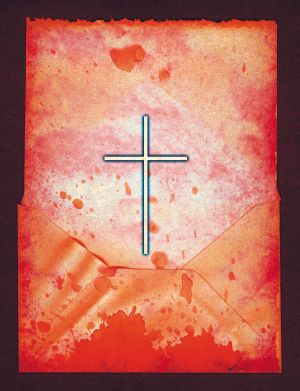1. Communion by numbers
 This brilliantly simple communion liturgy was originally created by Jonny Baker and the alternative worship community Grace, in London, and can be found in its original format on Jonny Baker's blog.
This brilliantly simple communion liturgy was originally created by Jonny Baker and the alternative worship community Grace, in London, and can be found in its original format on Jonny Baker's blog.
This really popular service was further developed and featured at the Greenbelt Festival as the 'Road to Emmaus Communion by Numbers' in the outdoor arena, with lots of deckchairs, windmills, envelopes with numbers on and use of the large outdoor screen. The full text/script of this particular service, with notes and the contents of the envelopes, can be found as attached files on the Fresh Worship website.
Later, a third version of the 'Road to Emmaus Communion by Numbers' was created for indoor use, which again can be found on the Fresh Worship website.
It just goes to show how much you can adapt this sort of gathering/service for your own context, especially if you film your local priest presiding at communion.
The basic idea is that people follow through the worship service together in small groups around tables set up in a café style. In the centre of each group is a series of envelopes numbered from 1-10. At the start of the worship, arrange everyone into groups of about six people. They begin by opening envelope number 1 and follow the instructions inside. When a bell rings, the group open the next numbered envelope and follow the instructions inside. That's it! The beauty of this worship experience is that it doesn't need to be led. It's up to the groups to make it happen.
The following script is from the third version with all the accompanying attachments and links.
2. Communion by numbers (indoor version)

Ten different people produced the ten different envelopes that follow through the story of the journey to Emmaus in Luke 24. This is the sequence.
- Chill/preparation – stand and read an appropriate prayer together, walk around and find a table to sit at while listening to a music track being played.
- Emmaus Road story – read the story from round the table from a Bible, then create an iconic candle kit.
- The hiddenness of God (Luke 24.13-16).
- Downcast (Luke 24.17-18) – on the table are parsley and salt water. What has made your soul downcast this week? Spend some time silently reflecting on ways in which you have wounded your life, the lives of others and the life of the world. When you are ready, take some parsley, dip it into the salt water and eat it. The salt water represents tears of repentance; the parsley represents new life that will grow. Then say a confession prayer from one of the Iona liturgies together.
- Storytelling part 1 – sharing our own stories (Luke 24.19-27).
- Storytelling part 2 – hearing God's story (Luke 24.19-27).
- Welcoming the stranger (Luke 24.28-29) – 'the flight to Emmaus': fill in landing cards for one another – it's how we welcome strangers to a country nowadays, and filling in the questions for the person sitting next to you makes you no longer strangers.
- Breaking bread (Luke 24.30-31).
- Burning hearts (Luke 24.32-35).
- Prayer and blessing.
3. World communion

Celebrate communion using bread from different parts of the world.
As part of the communion liturgy, use multiple loaves baked by members of the congregation with international recipes. Four loaves could represent the four corners of the world; five: the inhabited continents; six: all the continents; seven: the days of creation; ten: the Hebrew Ten Commandments; twelve: the disciples.
4. Create your own mosaic table for communion

In our brokenness, God is with us. Making a little table or tray for the bread and wine at communion from some of the broken bits of our lives can speak of how God carries us and transforms us through those times of feeling broken.
You will need: a slim box (perhaps made of wood) that will become the frame for the mosaic; tile adhesive; tile grout; bits of broken tiles to fill out the gaps.
The week/month before the gathering, encourage everyone to bring a small broken object that means something to him or her – eg, a favourite broken cup or broken photo frame – or something that represents their brokenness. Make sure people understand that it is unlikely that these objects will be returned. Place all the objects tightly up against each another like a mosaic in a strong slim box. Glue them with tile adhesive, making sure to fill out any major gaps with broken tiles. When this has dried, fill around all the items with tile grout.
Another alternative would be to invite everyone to smash a number of different coloured and textured ceramic tiles. Great to do when you're angry about something! Invite everyone to pick a piece that will represent their brokenness, then follow the instructions above.

